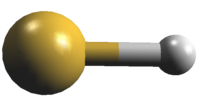|
Several sets of rotational, rovibrational, and electronic
data were fit simultaneously. These include the
v = 0 ground state rotational transitions along
with extensive higher frequency v = 0 and 1
terahertz and FIR data from
(1) M. A. Martin-Drumel, S. Eliet, O. Pirali, M. Guinet,
F. Hindle, G. Mouret, and A. Cuisset,
2012, Chem. Phys. Lett. 550, 8.
Also included are rotational data
from
(2) E. Klisch, T. Klaus, S. P. Belov, A. Dolgner,
R. Schieder, G. Winnewisser, and E. Herbst,
1996, Astrophys. J. 473, 1118;
as well as radiofrequency data
from
(3) W. L. Meerts and A. Dymanus,
1974, Astrophys. J. 187, L45.
Terahertz data from
(4) B. J. Drouin, J. C. Pearson, S. Yu, and
H. Gupta,
2013, IEEE Trans. Terahertz Sci. Technol.
3, 314;
were omitted from the fit because a considerable
fraction of the data is not compatible with
the remaining data within uncertainties.
Additional v = 0 FIR rotational data
from
(5) I. Morino and K. Kawaguchi,
1995, J. Mol. Spectrosc. 170, 172;
were superseded by the more extensive and more accurate
data from (1).
Also included in the fit were rovibrational
data from
(6) P. F. Bernath, T. Amano, and M. Wong,
1983, J. Mol. Spectrosc. 98, 20;
from
(7) R. J. Winkel, Jr., and S. P. Davis,
1984, Can. J. Mol. Phys. 62, 1420;
and from
(8) R. S. Ram, P. F. Bernath, R. Engleman, Jr.,
and J. W. Brault,
1995, J. Mol. Spectrosc. 172, 34.
P. F. Bernath is thanked for an output file of his
fit in (8) which was used as orientation of
uncertainties of (6-8).
In addition, v = 0 – 0 rovibronic data
were employed in the fit which were taken
from
(9) D. A. Ramsay,
1952, J. Chem. Phys. 20, 1920.
Transitions with uncertainties larger than
100 kHz have not been merged.
Predictions of transitions within each spin-substate
should be reliable throughout mainly because of
the extensive data from (1) and (7). Transitions
between the spin-substates should be viewed with
some caution.
Hund's case (b) quantum numbers were employed, as
usual. Levels with J + 0.5
= N correlate with
2Π1/2 and levels with
J – 0.5 = N
correlate with 2Π3/2.
The experimental dipole moment was determined in (3).
Rotational corrections to the dipole moment may
matter at higher rotational quantum numbers.
|
